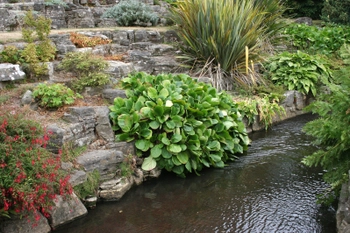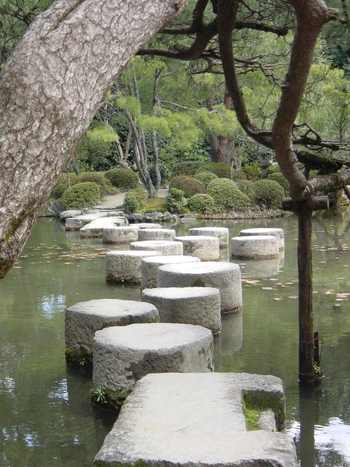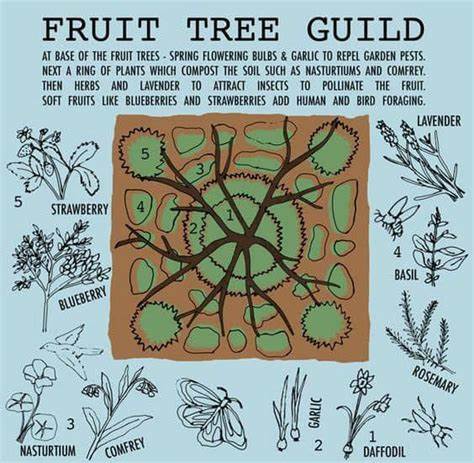A lot of people, interested in permaculture because of its regenerative nature, hesitate because they think permaculture gardens are, of necessity, messy and haphazard. And it’s true. Many of them are.
But it’s hardly a requirement.
A huge part of the appeal of this kind of gardening is that Nature does all the heavy lifting and we, the gardeners, get to slack off. So it can be easy to ignore the aesthetic aspects of design. That’s the human element being expressed. Our priorities are always quite obvious.
Nature is excellent at creating Beauty. Just look at this mountain, reflected in the water. Beautiful! It’s almost symmetrical, but not quite. But it is very harmonious.
Just look at this mountain, reflected in the water. Beautiful! It’s almost symmetrical, but not quite. But it is very harmonious.
It’s the human influences, confines, limitations and expectations on a landscape that create eyesores.
Within the context of Permaculture, you can and will create eyesores if you’re purely on the utilitarian and/or lazy end of the spectrum.
Or you can create true works of art, where form follows function, yes, but follows it in a way that is most pleasing to the eye and the sensibilities. Food for the soul.
Permaculture has so many principles to follow, so many inter-related elements to keep track of, so many functions to stack, across so many levels, from nitrogen fixing, to insectary plants, to good and bad companion plants…it’s easy to get lost in it all. Easy to forget the first thing anybody will see — what does it look like?
But adding aesthetics to an already complicated-seeming design process does not make it that much more difficult to figure out. On the contrary. It makes it easier. It gives you a place to start, a place to work out from. It creates the structure you need, the foundation to support experimentation and allow the wisdom of trial and error to lead the way…while still looking nice in the process.
In any good landscape design, what you need is one visually appealing and unifying feature. Then other elements, like hills, fruit tree guilds, or large sculptures can be placed in harmonious relation to it. This ties the whole thing together. It has many parts, but feels like one thing. That’s how the mind perceives Beauty. As balance. Tension and resolution. Harmony. These united elements create a whole, so much greater than the sum of it’s parts. Simplicity has a lot going on within it’s deceptively simple lines.
A nice broad pathway, for example, sweeping in a pleasantly meandering S curve from the back door of your house to the garage, and disappearing behind that stand of trees for a while, fills the bill. Even better with a nice breakfast patio made of the same material as the pathway. And still better, a raised bed kitchen garden enclosing the patio, also made of the same material as the patio and the pathway. Or maybe something that matches the privacy fence, instead. Whatever you want. It just needs to unify. Integrate rather than segregate. Then you can have endless little pathways, that don’t really show, but that allow you to get into the various parts of your various guilds. And these don’t have to be permanent. They can be stepping stones you re-arrange as needed.
But once you have the placement of the curved walkway figured out…
- use a rope or garden hose for the initial line, see it as drawing
- step back and look at it from the door
- re-arrange it
- step back again
- walk 500 miles going back and forth re-arranging it and checking how it looks from from the door
- then put a row of those little colored flags on each side of the rope
- make sure it’s wide enough for a wheel barrow
- make sure it’s wide enough for two to walk comfortably abreast, with space for the toddler and the dog
- repeat the back and forth process of seeing how it looks and adjusting it til you have it right
- now you know where your path/patio will be
- now you can build it
Once you have the placement of the curved (or straight) walkway figured out, then it becomes obvious where to put this guild and that multi-terraced raised bed you want to do and the compost heap, in relation to it.
The main thing to keep in mind is that your garden design should be congruent with the style and type of house you have. If you have a cute, modest little house, you don’t want a row of five foot tall Grecian urns lining your walkway. If, however, you live in a huge stately house, the Grecian urns may be just the thing. A fabulous finishing touch.
With variations and modifications, permaculture can fit into any style of garden you like. Even better, you can make up your own style. You’ll want to take different elements from different kinds of designs.

A cottage style, like this, lends itself perfectly to permaculture. Do larger borders, and maybe replace that lawn with Creeping Thyme or Roman Chamomile, and add a roundish bed in the middle. But the overall style is perfectly amenable.
A lovely set of terraces is also a perfect setting for permaculture. You’d probably want more beds than this garden has, and less rock surfaces, but the basic concept would be a great foundation for permaculture.


This kind of an arrangement does not have to be conventional, just for show, or a high maintenance struggle against natural forces.
It could be a food forest.
With log stairs leading up into the trees.
A modern, super architectural and Japanese inspired walkway can lead to a food forest. You probably wouldn’t want to trim your shrubs like that. But you could do bonsai-esque types of pruning. Nice open shapes, where the lines of the branches are shown off, instead of being buried in brambles.


Or a beautiful wild looking place. Those could be Paw Paw and dwarf Pear trees, with Blueberry bushes closest to the water. It could be punctuated with tall comfrey plants, instead of ornamental conifers. Better yet, why not have both?!
The Possibilities are Endless!
Limited only by your imagination. Even a tiny space has an infinity of nooks and crannies. Look at a million garden ideas online. They don’t have to be permaculture. Just get ideas. See what appeals, what you have the capacity to create, get some basic structures that will work on your site in mind, and let your imagination start churning.
It’s unbelievably fun!
A Thought Experiment – The Knot Garden

I seriously doubt anybody reading this has any interest in building a knot garden. I wouldn’t want to, either. But, as far as the idea of permaculture being able to fit into any type of garden style, I thought it would be a cool thought experiment to pretend this is something we wanted to do. Make a permaculture knot garden!
As a way to demonstrate Design Thinking. Because ridiculous extremes allow us to see things in an easier way.
I’m an artist. I’ve been doing Design Thinking all my life. I never knew it was “a thing” until a few years ago. I looked it up and said to myself, “Oh. Well, yeah. It’s just what you do.”
What is Design Thinking? Basically, it’s creative problem solving. Bringing together the skills, resources and limitations you have into something that not only works, but looks good doing it. We’ve been doing it forever. It’s only recently been coined as a “concept.” If you want to learn more about it, here’s an interesting article from MIT.
But on to the thought experiment!
Boxwood is the shrub most typically used for knot gardens. It has very dense growth and lends itself to this excessive pruning.
So the first question to ask, for our fictitious knot garden is, “Is boxwood a nitrogen fixer?” If it is, that would solve most of our problems, right off. I researched it for about a minute and a half. Got the distinct impression that it is not. Didn’t think it would be.
But with that as the first question…and a longer period of research… the obvious next questions would be are there any particular varieties of boxwood that, maybe, are nitrogen fixers? Or have edible berries? You’ll learn way more about boxwood than you ever wanted to, but that’s ok.
Let’s assume that, no. There is no variety of boxwood that fixes nitrogen. And no berries.
So the next step would be to start researching nitrogen fixing shrubs. We want them to be able to grow in your area. We want them to have berries. And they need to have a dense enough type of growth that lends itself to excessive pruning.
OK. You put in 12 hours of research, over three days, joined multiple forums and asked endless questions. And you have a huge messy pile of notes with all the traits of more nitrogen fixing shrubs than you can bear to think about. You’ve also crossed a lot of stuff off your list.
Three particular shrubs really appeal, for different reasons. None, however can be pruned so short. One can be kept about three feet tall and three feet wide. That’s workable. Another one needs to be bigger than that, but can be pruned to look like a small, gnarly tree. Hmmm, OK.
(Did you know Lilac is a nitrogen fixer? And she can be pruned to look just like that. And has many medicinal and culinary uses, too.)
The one you like the most, though, can be pruned as a nice hedge, about 6 feet tall. But you don’t want a hedge. What about four tall brackets in the corners? Oh, wait! The one in the SW corner will never get enough sun…
Arg!
What about a hedge of the tall one as a backdrop, with the smaller ones forming a sort of checkerboard pattern and the medium sized ones pruned to look like big bonsai trees, planted in every third open square and then just a bunch of short stuff under the trees and…
It’s becoming less and less like a knot garden.
But in the course of all this research, because you have to research the plants that go between the boxwood replacements, too, you’ve become less and less attached to the knot garden idea.
(We already knew you would.)
You’ve come across spiral herb gardens and those appeal. Maybe a whole row of spiral gardens, laid out like the orderly curls across Athena’s forehead…?
No. That would be dorky. What about a Really Big spiral garden…with steps going up the spiral? And a vermicomposting area on the top? So when it’s watered, the whole thing is awash in worm tea?
And you keep researching, keep learning. And what you finally put together looks nothing like a knot garden. It has a certain symmetry, an asymmetrical symmetry. Lovely walkways. It looks kind of cultivated, but also kind of wild. It has multiple heights, and layers and colors, and flowers and food of every type imaginable.
And the first thing a visitor sees? Is how beautiful it is!
Happy researching, planning, building, planting!
xxoo,
Anna







I’m loving this article on permaculture aesthetics and design thinking! It’s inspiring to see permaculture principles creating beautiful, sustainable landscapes by integrating nature’s patterns. Using plants as natural building materials is intriguing for both aesthetics and the environment.
How can we apply permaculture in space-constrained urban environments to bring its beauty and functionality to cities?
Hey Kiersti. Thanks for stopping by!
The cool thing about permaculture is how well it scales. It can be as big as an entire continent, or as small as a container garden on an apartment balcony. The principles remain the same.
Cities could easily implement permaculture in parkways and medians…not to mention parks and playgrounds. Instead of merely decorative plantings in these places, there could be food forests. And in parking lots, too. There could be lovely shade making parkways between the rows of parking spots, that have all the rainwater on the pavement directed down into their roots.
Most of it wouldn’t be too difficult to implement. The biggest hurdle is mindset. People would have to get over the idea that free food for the homeless and/or passersby should not be allowed…
Anna
Wow, with permaculture you can really let your imagination go and create just about anything you like, the possibilities are endless. I am sure, however, you would need to plant things that grow in your sort of climate easily, or you could spend your life battling the elements to keep your garden alive.
I like the wild look garden. I think a garden must look a little messy and mysterious with loads of colors and greens that stay green all year round.
Hi Michel
I like the wild look myself. But I know a lot of people are put off by it and think permaculture HAS to be wild looking tangles. I wanted to show that nothing was further from the case,
And yes, Of course. Planting stuff that does well in your area is the only way to go. The plants will be much stronger and more resilient. And if you want to have mostly perennials, it’s a necessity. Especially if you have harsh winters.
Thanks for stopping by!
Anna
Hey, permaculture aesthetics and design thinking are like the dynamic duo of eco-friendly creativity.
It’s basically making our living spaces a joy to be in. I like to think of it as nature’s art gallery meets your backyard. It is so easy on the eyes. Have you ever tried incorporating permaculture principles into your own space or garden?
It’s what I live for!